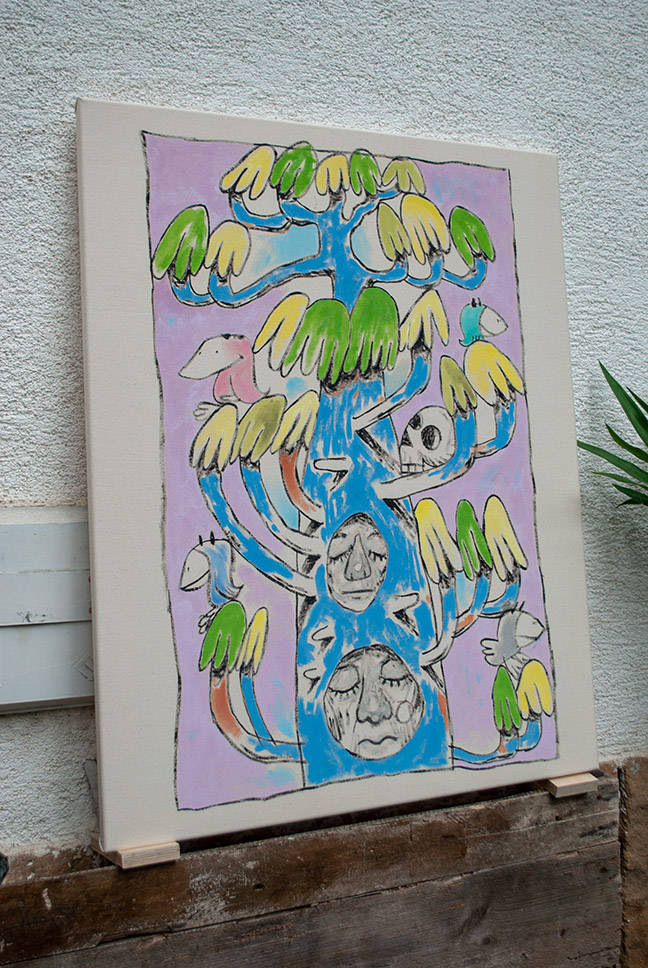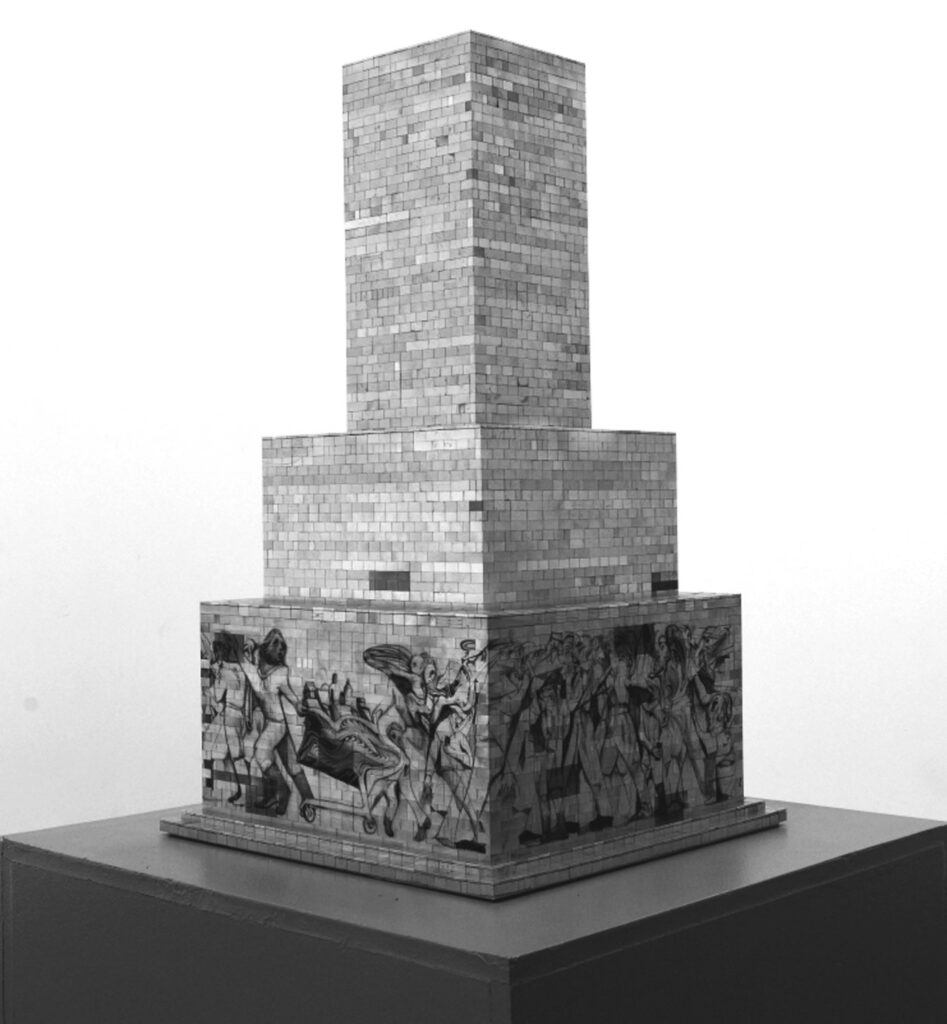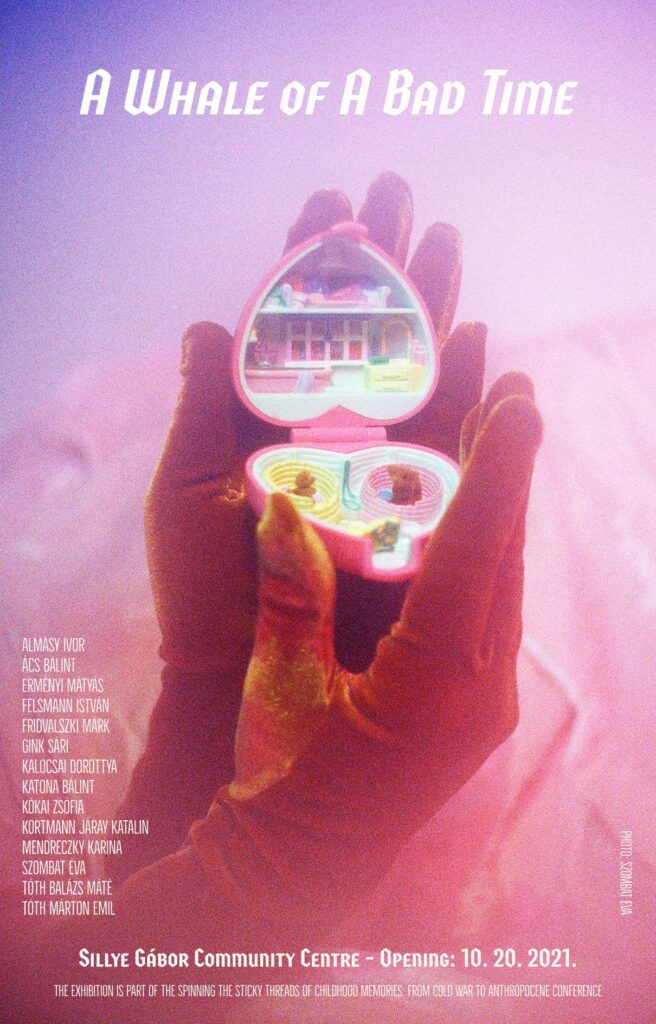The exhibition is the next stop of a travelling-group exhibition and event-program called ‘A Whale of a Bad Time’, organized by a curatorial team formed by six Hungarian artists, curators and theoreticians. The main theme of the project is the regional (East-Central European) perception of the era between the late 1980s and the early 2000s. How does the post-socialist identity resonate with Generation Y?

The project deals with private and collective memories of Generation Y, which, in the local context, also includes the first generation to be born free after the fall of the Sovietunion. The project contributors are in and around their thirties, which means that the aforementioned era overlaps with their childhood. The title of the program, A Whale of a Bad Time, also reflects a so-called flashbulb memory. The death of József Antall, the first democratically elected Prime Minister of Hungary, was announced as breaking news on TV during a Duck Tales episode (titled A Whale of a Bad Time) in 1993. This was the ‘free born’ generation’s first encounter with politics. The art projects presented at the exhibitions deal with various motifs referring to events, cultural phenomena and aesthetics that may act as similar memories to the vast majority of the Hungarian Generation Y.
When social scientist Roger Foster describes the adornoian relation to Proust, he highlights the connections between childhood and utopias: ‘Adorno often writes about childhood experience as a sort of refuge from the alienated, deadening forms of experience that prevail in the world of late modernity. Adorno developed this elevated sense of childhood, as a kind of placeholder for utopian social possibility […]’ (Foster, 2018.)
This lies at the core of our program. The representation of the ‘liberated’ 1990s era childhood is an allegory for lost possibilities, but, paradoxically, also for possible futures, both in local and global context. The project aim to refresh a certain collective mentality by sharing memories and experiences, by highlighting hopes and desires, but also by underlining the uncertainty inherited from failed utopias and promises.
In 1989, Fukuyama was already hoping that the ideological confrontations would end with the regime changes. In his view, the system of liberal democracy has triumphed forever. We now know that this is perhaps a not-so-easy process. With regard to the former Socialist Region, Stephen Holmes and Martin Müller point out that the “The spread of consumerism in the former Eastern Bloc turned attention away from high politics.” Right after the regime changed, the symbolic gesture of participation in the Western individual freedom and lifestyle manifested itself in the acquisition of its products. According to Borus Buden, the end of the postcommon means the end of an illusion: the end of the illusion of Western prosperity in the former socialist region.
But in the past decade, not only have the illusions of the society of a region begun to disappear, but on the global level, faith in the future also seems to be lost. The backward objects of socialism carry the warning remnants of an unfulfilled utopian vision, while the objects of the 1990s evoke a common memory of an over-optimistic vision in a global context.
To quote Svetlana Boym, nostalgic retrospect is not merely an individual state, but a symptom of our time, a pandemic that seems to be intensifying with modernity. The person or persons experiencing nostalgia transform history into a private and collective mythology, by which time becomes a space that can be traversed again. We have a responsibility, we need to distinguish between actual and, over time, changed and coloured by emotional “lost home” memories that we longin for.
The A Whale of a Bad Time/ Spinning the Sticky Threads of Childhood Memories: From Cold War to Anthropocene exhibition creates a traversable 1990s era of childhood space in the Gábor Sillye Cultural House in Hajdúböszörmény as part of the Spinning the Sticky Threads of Childhood Memories: From Cold War to Anthropocene conference. Through the works, participating artists critically examine their own past for both the local and global present (Consumption, sustainability, local endowments) while pointing out the hopes and needs for more ethical and sustainable practice, as well as more democratic norms, both for their own sake and for the common good of global society.



Organizers-Curators
Sári GINK is a doctoral student at MOME and a photographer at OSZK. Her artistic research interest is based on reconstructional methods in multimedia arts with a focus on place and object attachment. Her personal brand called Rose & Berry is a heritage brand which deals with personal memory through collective memory that interacts with her professional practice from her solo shows to collaborative projects.
Dorottya KALOCSAI is a fine artist. She participated in the Artist-in-Residence program in Vienna (Museumsquartier, Q21, 2016). She was shortlisted for the Esterházy Art Award in 2019. She took part in group shows and solo exhibitions in Budapest, Vienna, London and Bratislava.
Karina MENDRECZKY is a fine artist. She won the Preis der Kunsthalle Wien in 2015. Her works are frequently shown in Vienna and Budapest. Her current solo show in Vienna explored personal memory and femininity in a generational context.
Katalin KORTMANN-JÁRAY is a fine artist and a doctoral student at the HUFA. She took part in group shows, Biennials, Triennials, Prizes-Awards in Several European countries. The main topic of her works is the influence of culture on human perception.
Bálint ÁCS is a PhD student at ELTE. The focus of his research is the history and cultural policy background of Hungarian contemporary art museums. His critics, interviews and essays have been published in Hungarian cultural magazines.
Zsófia KÓKAI is a curator and member of the MŰTŐ artist-run space and collective. She currently works at Artpool Art Research Center and is a coordinator and co-curator of the Visegrad Fund project Alterum – Artist-run network in the CEE region.
Participating Artists
Sári GINK (Please find her bio above, she is a member of the curatorial team.)
Katalin KORTMANN-JÁRAY (Please find her bio above, she is a member of the curatorial team.)
Karina MENDRECZKY (Please find her bio above, she is a member of the curatorial team.)
Dorottya KALOCSAI (Please find her bio above, she is a member of the curatorial team.)
Ivor ALMÁSY is a Budapest based fine artist, with classical printmaking background. He has an interest in experimental, analog film making. In 2020 he won the Derkovits Scholarship. Through his works he tries to process the effect of personal and family memories to the present. He is a member of the Sekrestye art collective.
István FELSMANN graduated at the Hungarian University of Fine Arts in Painting Faculty in 2012. Actually he lives and works in Budapest. He has mostly exhibited in Hungary, but he also had exhibitions in several European countries. The Lego Abstract Relief is the most completed series in his art.
Márk FRIDVALSZKI (born Budapest, lives and works in Berlin) graduated from the Academy of Fine Arts in Vienna in 2011 and was a postgraduate Meisterschüler student at the Academy of Fine Arts in Leipzig (2014–2017). Fridvalszki is the co-initiator and graphic editor of the publishing project and cross-disciplinary collective Technologie und das Unheimliche (since 2014). Mark Fridvalszki participated in various exhibitions and art events, such as of 34th Ljubljana Biennale of Graphic Arts (2021), Kunstverein am Rosa-Luxemburg-Platz in Berlin (2021), Narracje Festival in Gdańsk (2021), Kunstraum Lakeside in Klagenfurt (2021), Institute of Contemporary Art Dunaújváros (2020), TIC Gallery in Brno (2020), Ludwig Museum in Budapest (2019).
Éva SZOMBAT is a photographer working and living in Budapest. She got her masters’ degree in Photography from Moholy-Nagy University of Art and Design (MOME). She released two books on happiness and its effect on people: the limited edition Happiness and Practitioners. She won scholarships in Paris and New York. Her works were displayed in New York, Jerusalem, Lisbon, Vienna, Berlin, Amsterdam, among other places. She is currently working on a series about female sexuality. She is also teaching photography at MOME.
Balázs Máté TÓTH is a Budapest based artist. Graduated as a sculptor, but he works with a wide spectrum of medium: graphics, costumes, animation, board games, installations. He won the Derkovitsscholarship three times. His works are based on social criticism with a sense of humour. In 2017 he started his MascotLand series, which is based on the japanese yuru-chara subculture. These mascots are the reflections of the current social problems such as antisemitism, addictions, xenophobia, etc.
Márton Emil TÓTH is a Budapest based fine artist. He has graduated at the Hungarian University of Fine Arts. He is a member of the „NEM MI VOLTUNK” art collective. He has exhibited in several European countries and has participated in several international Interdisciplinary projects. He has won the Derkovitsscholarship in 2019.
Mátyás ERMÉNYI is a Budapest based artist. He has graduated at the Hungarian University of Fine Arts in Painting Faculty. He has exhibited in Hungary and in several European countries. Erményi’s recent works evoke the aesthetics of socialist cartoons. The distinctive formal world of his pictures merges with his own personal memories.
Bálint KATONA is a hungarian engineer-music composer. As Katona was nurtured up in an a part artist, part engineering family art was a constant element in his early years. Since, when producing, he’s been focusing on value-added art that enables or empowers rather than standing for its own.
